
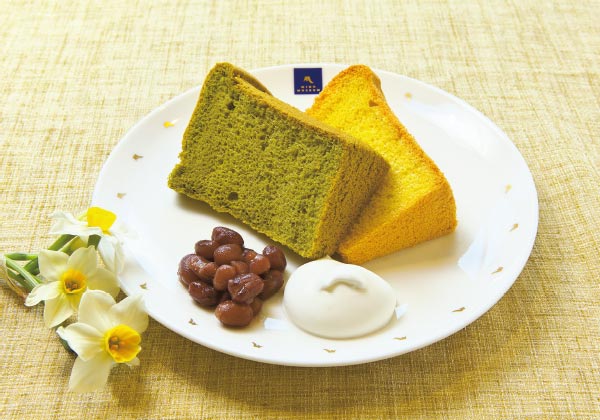

A gentle breeze filled with sunshine blows over a field of grass. School girls laugh wholeheartedly. That’s the sensation of our rice-flour chiffon cake!!

The plain chiffon cake is not only super soft, it is thoroughly baked and has a very light flavor. One bite and you feel like your body is about to float gently into the air. The surface of the cake has a fine soft skin, and when you eat it, the interior is ever so slightly fragrant and somewhat familiar. The matcha chiffon cake, on the other hand, has a little more depth. It is super moist and melts in your mouth. Add adzuki beans and fresh cream for a traditional Japanese flavor. How do they create such a light and fluffy cake?

The finest rice made with the Shumei Natural Agriculture farming method is regularly delivered to MIHO MUSEUM. In addition, the museum uses Natural Agriculture eggs, sugar, matcha, adzuki beans, and a rape seed-olive oil blend-all grown without the use of pesticides, chemical fertilizers, and antibiotics-in their delicious culinary creations. Our pastry chefs wondered if the delicious rice flavor could be applied to something else and began to experiment. Rice-flour cakes, a popular item these days, would undoubtedly be delicious.

The road, however, was not so easy. Even though the chefs made a tasty cake, it was not very fluffy. Rice flour doesn’t contain glutens like wheat flour so they could only depend on the egg white to make the flour rise. Usually, the egg white is whipped until it stands firm and won’t fall out of an upturned bowl. Rice flour requires extra effort to whip, whip, and whip the egg white until it won’t move no matter how much the bowl is shaken. But if the egg white is overwhipped, it becomes dry and turns into dried skin when baked, so it has be whipped just the right amount. The sugar that is added in three parts comes from Miyakojima Island in Okinawa.

After years of natural farming, the sugar has become more white and so fine and light that if you get some on your hands, it will disappear into your finger prints. Now, the beaten egg white is mixed in a bowl with the yolk, water, oil, and rice flour. Gently, the batter is made fluffy with tiny bubbles, then the bowl is slowly raised and the batter poured into a tube pan. But something is missing in order to make the batter expand.

At a loss, the chefs consulted the writings of a baker known as the “pioneer of rice-flour bread.” The ultimate trick they learned there was the grinding of rice flour. The miller introduced in the book taught them about an air-swept pulverizer. Compared to the flour used previously, the particles of the flour from the pulverizer was decisively finer and so light that when it was shaken, it seemed like the flour would float up with the bag and all. When the cake was made with this rice flour, the batter rose so high it almost flowed over the top of the pan. Cuisine and sweets are truly a composite work of art created by all those involved. Nothing can be omitted in order to make the best of the best.

Another important flavor is the tsubuan or “chunky” bean paste. Adzuki beans from Hokkaido, Tanba, and various regions throughout Japan began to arrive. The difference in taste depending on the region is actually very pronounced. There is the sturdy, strong flavor cultivated in the plateaus of Hokkaido, the exceptionally refined flavor of Tanba beans that hints at traditional Kyoto sweets, and the gentle flavor of another producing area? One year, the order for adzuki beans was put out very late and all the beans from the other regions were sold out except for one place, where they saved the beans for us. One chef said, “I was so happy I could have cried.” When this chef opened the bag of beans that arrived, a soft gentleness seemed to rise from the beans. The flour, sugar, eggs, and beans all change from time to time. Even though they are in the same packaging, the content changes. While adapting to and respecting that which nature gives us, our pastry chefs continue to make desserts. They ask, “Rice Flour, how are you today?”
The plain chiffon cake is not only super soft, it is thoroughly baked and has a very light flavor. One bite and you feel like your body is about to float gently into the air. The surface of the cake has a fine soft skin, and when you eat it, the interior is ever so slightly fragrant and somewhat familiar. The matcha chiffon cake, on the other hand, has a little more depth. It is super moist and melts in your mouth. Add adzuki beans and fresh cream for a traditional Japanese flavor. How do they create such a light and fluffy cake?
The finest rice made with the Shumei Natural Agriculture farming method is regularly delivered to MIHO MUSEUM. In addition, the museum uses Natural Agriculture eggs, sugar, matcha, adzuki beans, and a rape seed-olive oil blend-all grown without the use of pesticides, chemical fertilizers, and antibiotics-in their delicious culinary creations. Our pastry chefs wondered if the delicious rice flavor could be applied to something else and began to experiment. Rice-flour cakes, a popular item these days, would undoubtedly be delicious.
The road, however, was not so easy. Even though the chefs made a tasty cake, it was not very fluffy. Rice flour doesn’t contain glutens like wheat flour so they could only depend on the egg white to make the flour rise. Usually, the egg white is whipped until it stands firm and won’t fall out of an upturned bowl. Rice flour requires extra effort to whip, whip, and whip the egg white until it won’t move no matter how much the bowl is shaken. But if the egg white is overwhipped, it becomes dry and turns into dried skin when baked, so it has be whipped just the right amount. The sugar that is added in three parts comes from Miyakojima Island in Okinawa.
After years of natural farming, the sugar has become more white and so fine and light that if you get some on your hands, it will disappear into your finger prints. Now, the beaten egg white is mixed in a bowl with the yolk, water, oil, and rice flour. Gently, the batter is made fluffy with tiny bubbles, then the bowl is slowly raised and the batter poured into a tube pan. But something is missing in order to make the batter expand.
At a loss, the chefs consulted the writings of a baker known as the “pioneer of rice-flour bread.” The ultimate trick they learned there was the grinding of rice flour. The miller introduced in the book taught them about an air-swept pulverizer. Compared to the flour used previously, the particles of the flour from the pulverizer was decisively finer and so light that when it was shaken, it seemed like the flour would float up with the bag and all. When the cake was made with this rice flour, the batter rose so high it almost flowed over the top of the pan. Cuisine and sweets are truly a composite work of art created by all those involved. Nothing can be omitted in order to make the best of the best.
Another important flavor is the tsubuan or “chunky” bean paste. Adzuki beans from Hokkaido, Tanba, and various regions throughout Japan began to arrive. The difference in taste depending on the region is actually very pronounced. There is the sturdy, strong flavor cultivated in the plateaus of Hokkaido, the exceptionally refined flavor of Tanba beans that hints at traditional Kyoto sweets, and the gentle flavor of another producing area? One year, the order for adzuki beans was put out very late and all the beans from the other regions were sold out except for one place, where they saved the beans for us. One chef said, “I was so happy I could have cried.” When this chef opened the bag of beans that arrived, a soft gentleness seemed to rise from the beans. The flour, sugar, eggs, and beans all change from time to time. Even though they are in the same packaging, the content changes. While adapting to and respecting that which nature gives us, our pastry chefs continue to make desserts. They ask, “Rice Flour, how are you today?”
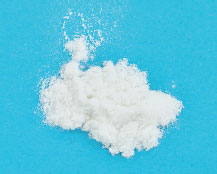
Our finely pulverized rice
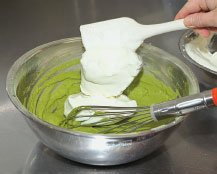
The stiffly beaten egg white
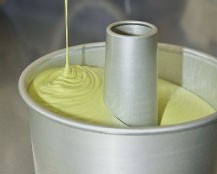
Pouring the batter quickly into the pan.
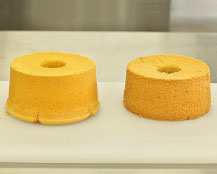
The way the rice flour is milled makes all the difference.
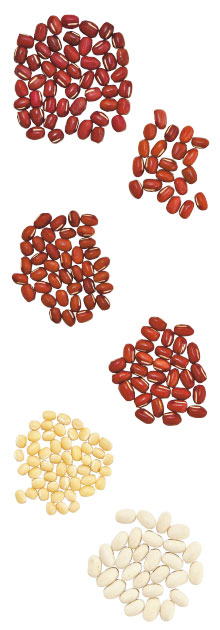
Hokkaido, Tanba, and other regional adzuki beans and white tebou beans.
Please look forward to which one you will be served.
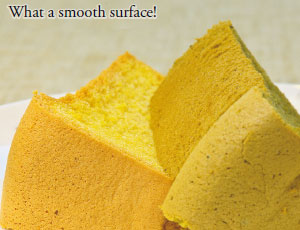 |
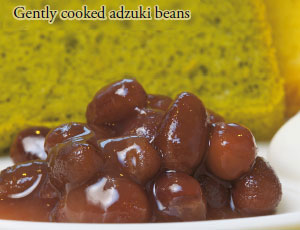 |